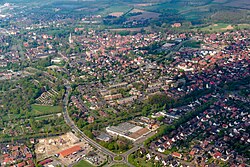Lüdinghausen
 From Wikipedia - Reading time: 7 min
From Wikipedia - Reading time: 7 min
Lüdinghausen | |
|---|---|
 Aerial photo of Lüdinghausen | |
Location of Lüdinghausen within Coesfeld district  | |
| Coordinates: 51°46′N 7°26′E / 51.767°N 7.433°E | |
| Country | Germany |
| State | North Rhine-Westphalia |
| Admin. region | Münster |
| District | Coesfeld |
| Subdivisions | 2 |
| Government | |
| • Mayor (2020–25) | Ansgar Mertens[1] (CDU) |
| Area | |
• Total | 140.31 km2 (54.17 sq mi) |
| Highest elevation | 110 m (360 ft) |
| Lowest elevation | 52 m (171 ft) |
| Population (2023-12-31)[2] | |
• Total | 25,306 |
| • Density | 180/km2 (470/sq mi) |
| Time zone | UTC+01:00 (CET) |
| • Summer (DST) | UTC+02:00 (CEST) |
| Postal codes | 59348 |
| Dialling codes | 02591 |
| Vehicle registration | COE, LH |
| Website | www.luedinghausen.de |
Lüdinghausen (Westphalian: Lünkhusen or Lünksel) is a town in district of Coesfeld in the state of North Rhine-Westphalia, Germany. It is located on the Dortmund-Ems Canal, approx. 25 km south-west of Münster.
Town parts
[edit]The town of Lüdinghausen includes the village of Seppenrade, where the ammonite Parapuzosia seppenradensis was found in 1895.
History
[edit]Lüdinghausen was founded in the thirteenth century and received its first city charter around 1308.[3]
Transportation
[edit]Lüdinghausen is situated at the Dortmund-Enschede railway, and has a train station (Lüdinghausen railway station). Flugplatz Borkenberge (Borkenberge Airport) (ICAO code: EDLB) is located in the Ludinghausen area.
Sights
[edit]Lüdinghausen is known for its three castles, Castle Luedinghausen, Kakesbeck Castle and Vischering Castle.[4]
Twin towns – sister cities
[edit]Lüdinghausen is twinned with:[5]
Notable people
[edit]- Holger Blume (born 1973), springer
- Marc Blume (born 1973), sprinter
- Marie Theres Fögen (1946–2008), jurist and historian
- Franz Kamphaus (born 1932), Roman Catholic bishop
- Johannes Kriege (1859–1937), jurist and politician (DVP)
- Wiebke Muhsal (born 1986), politician (AfD)
- Amos Pieper (born 1998), footballer
- Bettina Schausten (born 1965), journalist
- Karin Schnaase (born 1985), badminton player
- Bernd Strasser (born 1936), water polo player
- Heiner Thade (born 1942), modern penthalete
- Wilm Weppelmann (born 1957), artist
- Franz Wernekinck (1764–1839), physician and botanist
- Jens Albert (born 1973), rapper
References
[edit]- ^ Wahlergebnisse in NRW Kommunalwahlen 2020, Land Nordrhein-Westfalen, accessed 19 June 2021.
- ^ "Bevölkerung der Gemeinden Nordrhein-Westfalens am 31. Dezember 2023 – Fortschreibung des Bevölkerungsstandes auf Basis des Zensus vom 9. Mai 2011" (in German). Landesbetrieb Information und Technik NRW. Retrieved 2024-06-20.
- ^ Hartemink, Ralf (1996). "Wappen von Lüdinghausen". Heraldry of the World. Retrieved 2008-09-10.
- ^ "Stadt Lüdinghausen – Offizielle Website".
- ^ "Partnerstädte" (in German). Lüdinghausen. Retrieved 2021-12-09.
External links
[edit]- Official website (in German)
 KSF
KSF



